engine oil Alfa Romeo 147 2005 Owner handbook (in English)
[x] Cancel search | Manufacturer: ALFA ROMEO, Model Year: 2005, Model line: 147, Model: Alfa Romeo 147 2005Pages: 291, PDF Size: 5.52 MB
Page 74 of 291
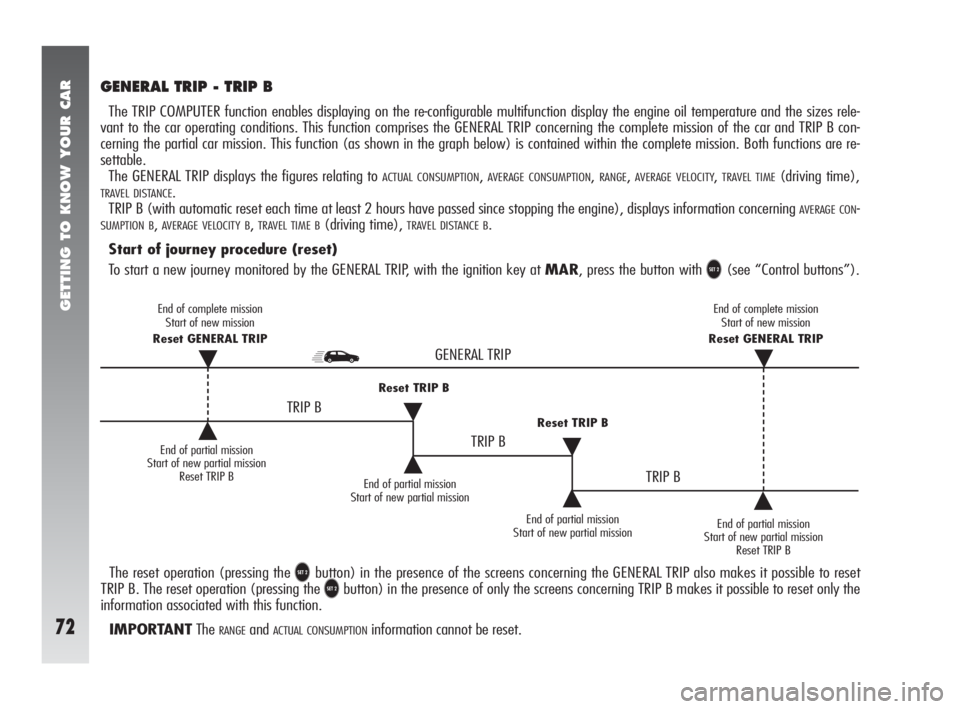
GETTING TO KNOW YOUR CAR
72
GENERAL TRIP - TRIP B
The TRIP COMPUTER function enables displaying on the re-configurable multifunction display the engine oil temperature and the sizes rele-
vant to the car operating conditions. This function comprises the GENERAL TRIP concerning the complete mission of the car and TRIP B con-
cerning the partial car mission. This function (as shown in the graph below) is contained within the complete mission. Both functions are re-
settable.
The GENERAL TRIP displays the figures relating to
ACTUAL CONSUMPTION,AVERAGE CONSUMPTION,RANGE,AVERAGE VELOCITY,TRAVEL TIME(driving time),
TRAVEL DISTANCE.
TRIP B (with automatic reset each time at least 2 hours have passed since stopping the engine), displays information concerning
AVERAGE CON-
SUMPTION B,AVERAGE VELOCITY B,TRAVEL TIME B(driving time), TRAVEL DISTANCE B.
Start of journey procedure (reset)
To start a new journey monitored by the GENERAL TRIP, with the ignition key at MAR, press the button with
U(see “Control buttons”).
The reset operation (pressing the
Ubutton) in the presence of the screens concerning the GENERAL TRIP also makes it possible to reset
TRIP B. The reset operation (pressing the
Ubutton) in the presence of only the screens concerning TRIP B makes it possible to reset only the
information associated with this function.
IMPORTANTThe
RANGEandACTUAL CONSUMPTIONinformation cannot be reset.
End of partial mission
Start of new partial mission
Reset TRIP B
˙Reset TRIP B
End of partial mission
Start of new partial mission˙
˙Reset TRIP B
˙˙
˙
TRIP B
TRIP B
TRIP B
End of partial mission
Start of new partial missionEnd of partial mission
Start of new partial mission
Reset TRIP B
GENERAL TRIP
End of complete mission
Start of new mission
Reset GENERAL TRIP
˙
End of complete mission
Start of new mission
Reset GENERAL TRIP
˙
Page 80 of 291
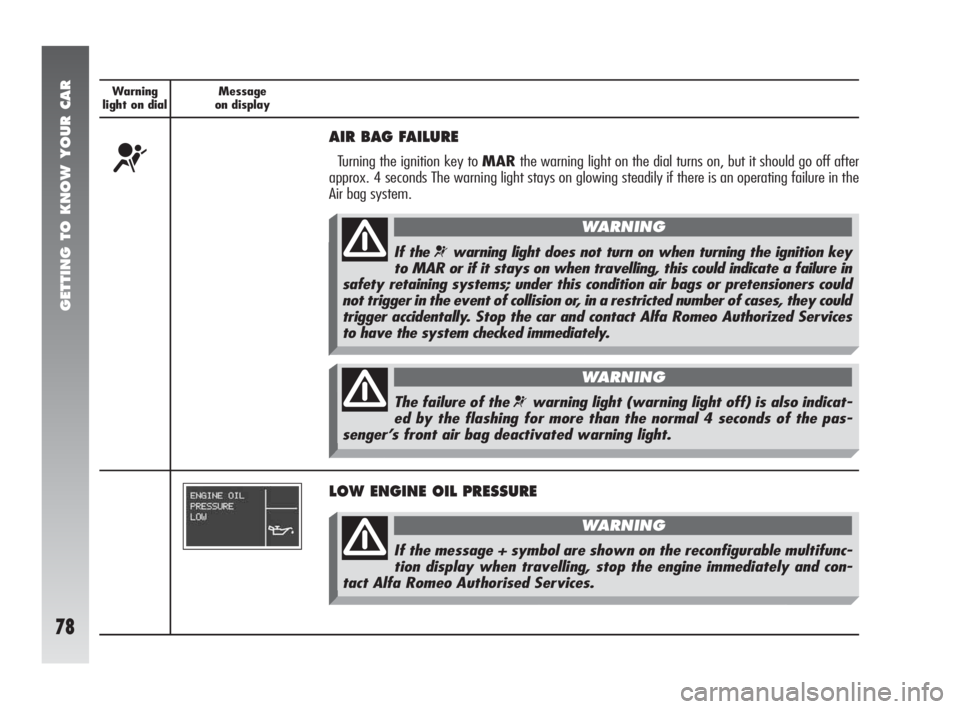
GETTING TO KNOW YOUR CAR
78
Warning
light on dialMessage
on display
¬
AIR BAG FAILURE
Turning the ignition key to MARthe warning light on the dial turns on, but it should go off after
approx. 4 seconds The warning light stays on glowing steadily if there is an operating failure in the
Air bag system.
LOW ENGINE OIL PRESSURE
If the message + symbol are shown on the reconfigurable multifunc-
tion display when travelling, stop the engine immediately and con-
tact Alfa Romeo Authorised Services.
WARNING
If the ¬warning light does not turn on when turning the ignition key
to MAR or if it stays on when travelling, this could indicate a failure in
safety retaining systems; under this condition air bags or pretensioners could
not trigger in the event of collision or, in a restricted number of cases, they could
trigger accidentally. Stop the car and contact Alfa Romeo Authorized Services
to have the system checked immediately.
WARNING
The failure of the ¬warning light (warning light off) is also indicat-
ed by the flashing for more than the normal 4 seconds of the pas-
senger’s front air bag deactivated warning light.
WARNING
Page 106 of 291
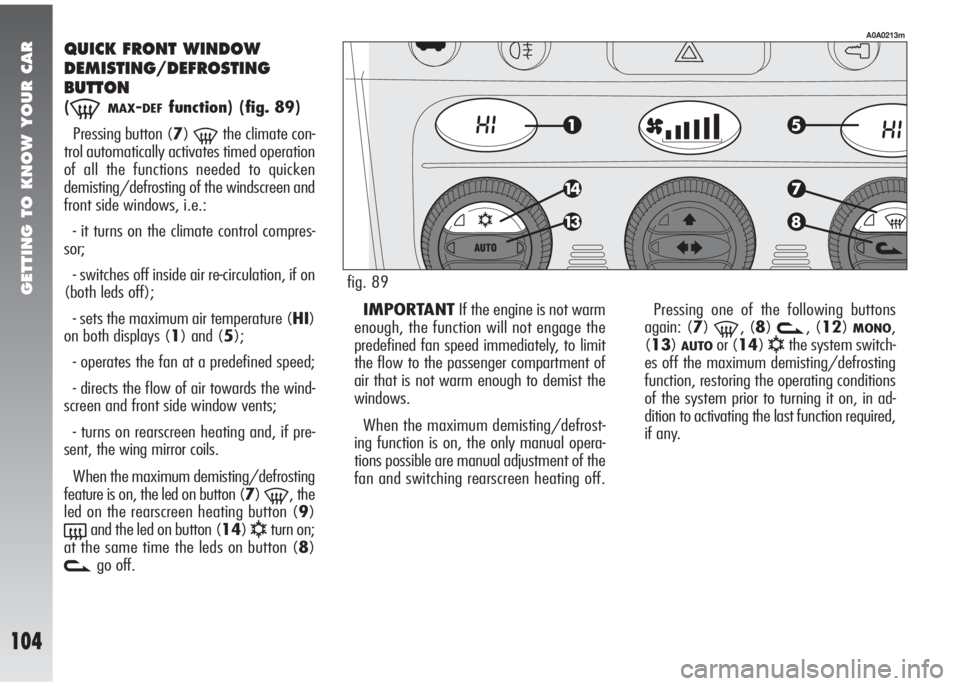
GETTING TO KNOW YOUR CAR
104
QUICK FRONT WINDOW
DEMISTING/DEFROSTING
BUTTON
(-MAX-DEFfunction)(fig. 89)
Pressing button (7)
-the climate con-
trol automatically activates timed operation
of all the functions needed to quicken
demisting/defrosting of the windscreen and
front side windows, i.e.:
- it turns on the climate control compres-
sor;
- switches off inside air re-circulation, if on
(both leds off);
- sets the maximum air temperature (HI)
on both displays (1) and (5);
- operates the fan at a predefined speed;
- directs the flow of air towards the wind-
screen and front side window vents;
- turns on rearscreen heating and, if pre-
sent, the wing mirror coils.
When the maximum demisting/defrosting
feature is on, the led on button (7)
-, the
led on the rearscreen heating button (9)
(and the led on button (14)√turn on;
at the same time the leds on button (8)
vgo off.IMPORTANTIf the engine is not warm
enough, the function will not engage the
predefined fan speed immediately, to limit
the flow to the passenger compartment of
air that is not warm enough to demist the
windows.
When the maximum demisting/defrost-
ing function is on, the only manual opera-
tions possible are manual adjustment of the
fan and switching rearscreen heating off.Pressing one of the following buttons
again: (7)
-, (8)v, (12)MONO,
(13)
AUTOor (14)√the system switch-
es off the maximum demisting/defrosting
function, restoring the operating conditions
of the system prior to turning it on, in ad-
dition to activating the last function required,
if any.
A0A0213m
fig. 89
Page 107 of 291
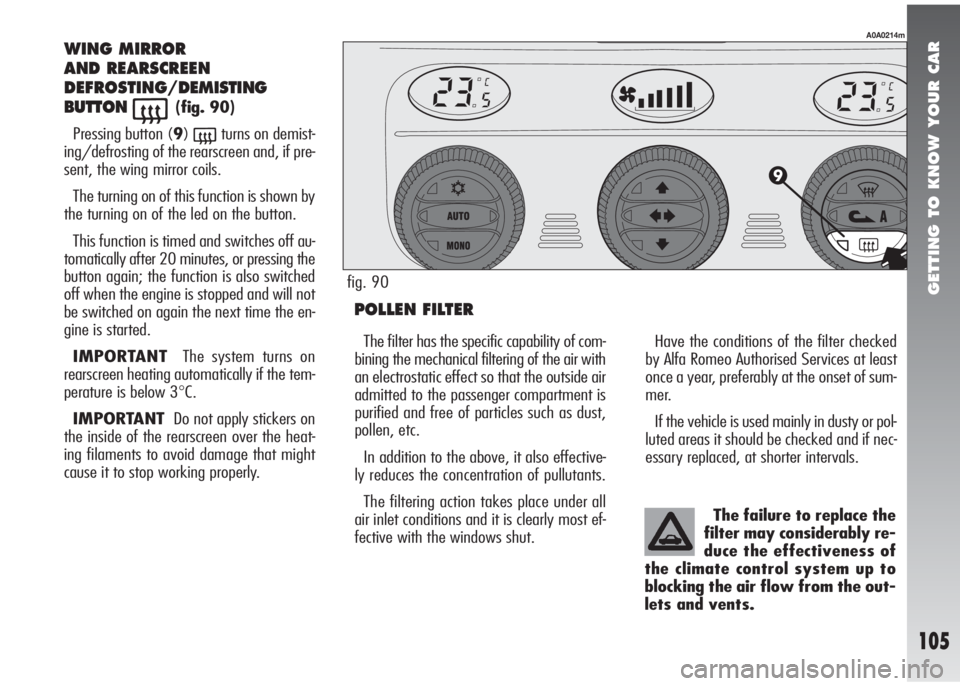
GETTING TO KNOW YOUR CAR
105
WING MIRROR
AND REARSCREEN
DEFROSTING/DEMISTING
BUTTON
((fig. 90)
Pressing button (9)
(turns on demist-
ing/defrosting of the rearscreen and, if pre-
sent, the wing mirror coils.
The turning on of this function is shown by
the turning on of the led on the button.
This function is timed and switches off au-
tomatically after 20 minutes, or pressing the
button again; the function is also switched
off when the engine is stopped and will not
be switched on again the next time the en-
gine is started.
IMPORTANTThe system turns on
rearscreen heating automatically if the tem-
perature is below 3
°C.
IMPORTANTDo not apply stickers on
the inside of the rearscreen over the heat-
ing filaments to avoid damage that might
cause it to stop working properly.
POLLEN FILTER
Have the conditions of the filter checked
by Alfa Romeo Authorised Services at least
once a year, preferably at the onset of sum-
mer.
If the vehicle is used mainly in dusty or pol-
luted areas it should be checked and if nec-
essary replaced, at shorter intervals.
A0A0214m
The filter has the specific capability of com-
bining the mechanical filtering of the air with
an electrostatic effect so that the outside air
admitted to the passenger compartment is
purified and free of particles such as dust,
pollen, etc.
In addition to the above, it also effective-
ly reduces the concentration of pullutants.
The filtering action takes place under all
air inlet conditions and it is clearly most ef-
fective with the windows shut.The failure to replace the
filter may considerably re-
duce the effectiveness of
the climate control system up to
blocking the air flow from the out-
lets and vents.
fig. 90
Page 138 of 291
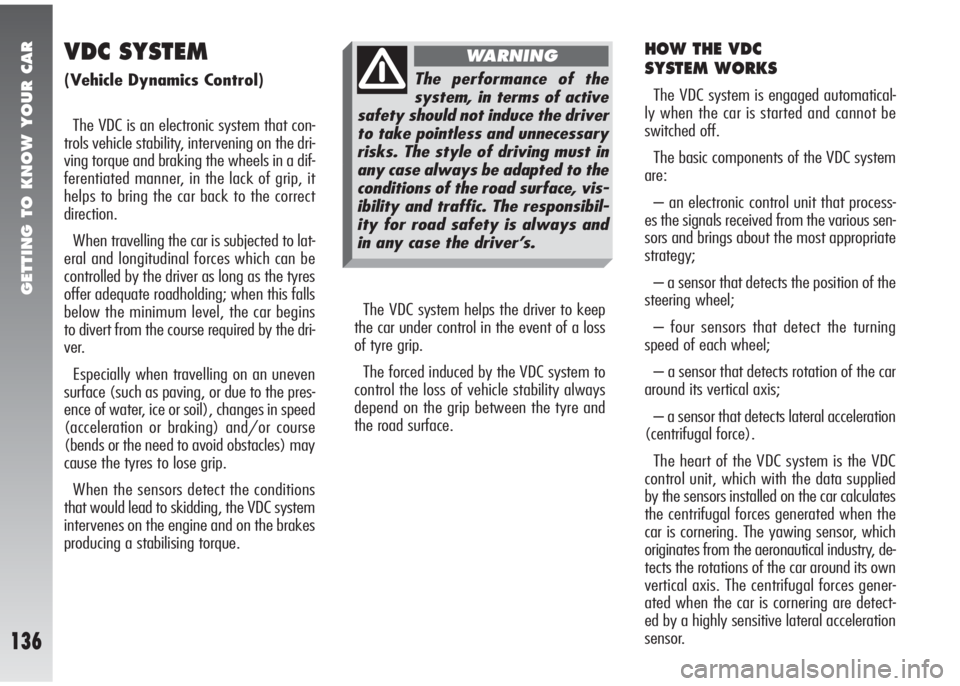
GETTING TO KNOW YOUR CAR
136
VDC SYSTEM
(Vehicle Dynamics Control)
The VDC is an electronic system that con-
trols vehicle stability, intervening on the dri-
ving torque and braking the wheels in a dif-
ferentiated manner, in the lack of grip, it
helps to bring the car back to the correct
direction.
When travelling the car is subjected to lat-
eral and longitudinal forces which can be
controlled by the driver as long as the tyres
offer adequate roadholding; when this falls
below the minimum level, the car begins
to divert from the course required by the dri-
ver.
Especially when travelling on an uneven
surface (such as paving, or due to the pres-
ence of water, ice or soil), changes in speed
(acceleration or braking) and/or course
(bends or the need to avoid obstacles) may
cause the tyres to lose grip.
When the sensors detect the conditions
that would lead to skidding, the VDC system
intervenes on the engine and on the brakes
producing a stabilising torque.
HOW THE VDC
SYSTEM WORKS
The VDC system is engaged automatical-
ly when the car is started and cannot be
switched off.
The basic components of the VDC system
are:
– an electronic control unit that process-
es the signals received from the various sen-
sors and brings about the most appropriate
strategy;
– a sensor that detects the position of the
steering wheel;
– four sensors that detect the turning
speed of each wheel;
– a sensor that detects rotation of the car
around its vertical axis;
– a sensor that detects lateral acceleration
(centrifugal force).
The heart of the VDC system is the VDC
control unit, which with the data supplied
by the sensors installed on the car calculates
the centrifugal forces generated when the
car is cornering. The yawing sensor, which
originates from the aeronautical industry, de-
tects the rotations of the car around its own
vertical axis. The centrifugal forces gener-
ated when the car is cornering are detect-
ed by a highly sensitive lateral acceleration
sensor. The VDC system helps the driver to keep
the car under control in the event of a loss
of tyre grip.
The forced induced by the VDC system to
control the loss of vehicle stability always
depend on the grip between the tyre and
the road surface.
The performance of the
system, in terms of active
safety should not induce the driver
to take pointless and unnecessary
risks. The style of driving must in
any case always be adapted to the
conditions of the road surface, vis-
ibility and traffic. The responsibil-
ity for road safety is always and
in any case the driver’s.
WARNING
Page 176 of 291

GETTING TO KNOW YOUR CAR
174
EMISSION REDUCING DEVICES
Trivalent catalytic converter
(catalytic silencer)
The exhaust system is fitted with a cata-
lyst formed of alloys of precious metals; it
is housed in a stainless steel container which
is able to withstand the high operating tem-
peratures.
The catalyst converts the unburnt hydro-
carbons, carbon monoxide and nitric oxide
in the exhaust gas (even in minimal quan-
tity owing to the electronic ignition and in-
jection systems) into non polluting com-
pounds.Lambda sensors
Lambda sensors measure the content of
oxygen present in the exhaust gas. The sig-
nal transmitted by the Lambda sensors is
used by the injection and ignition electron-
ic control unit to adjust the air - fuel mixture.
Anti-evaporation system
As it is impossible, even when the engine
is switched off, to prevent the formation of
fuel vapours, a system has been devised
which traps the vapours in a special acti-
vated carbon container.
When the engine is running these vapours
are withdrawn and sent to combustion.
ENVIRONMENTAL
PROTECTION
The design and construction of the vehi-
cle have not only been developed with the
traditional aspects of performance and safe-
ty in mind, but also take into account the in-
creasingly pressing problems tied to pro-
tecting the environment.
The choice of materials, techniques and
particular parts are the result of work which
has made it possible to drastically reduce
the harmful effects on the environment and
guarantee compliance with the most strin-
gent international regulations.
USE OF NON-TOXIC
MATERIALS
None of the components of the vehicle con-
tain asbestos. The padding and the climate
control system do not contain CFCs which
are held responsible for the destruction of
the ozone layer.
The colouring agents and the corrosion in-
hibitors used on the nuts, screws and bolts
do not contain cadmium or chrome which
could pollute the atmosphere or water tables.
Due to the high tempera-
tures reached during oper-
ation of the catalytic silencer the
vehicle should not be parked over
inflammable materials (paper, fu-
el oils, grass, dry leaves etc.).
WARNING
Page 180 of 291
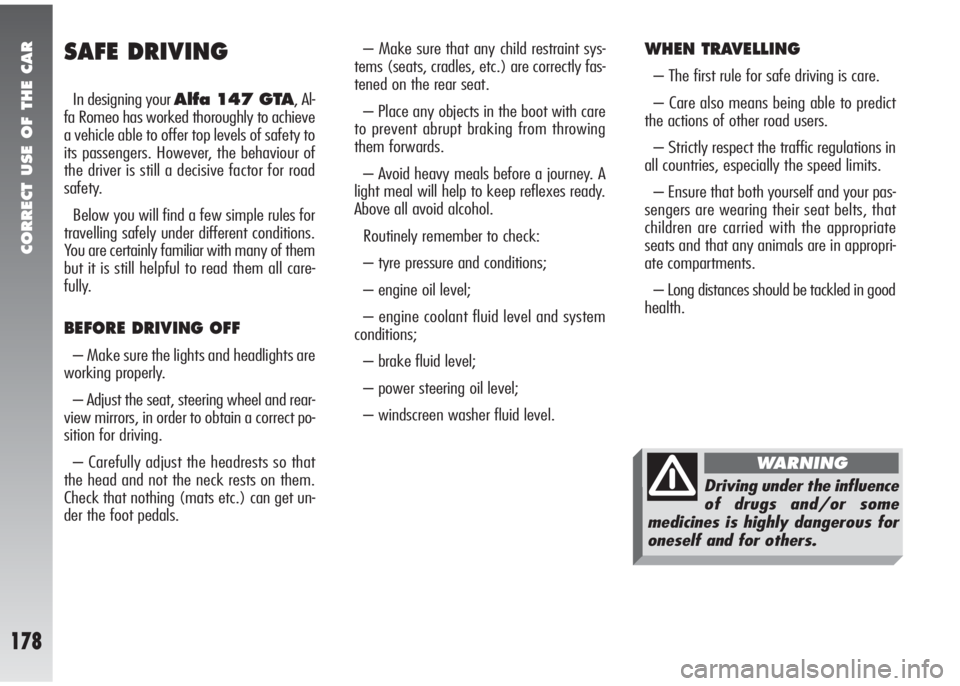
CORRECT USE OF THE CAR
178
SAFE DRIVING
In designing your Alfa 147 GTA, Al-
fa Romeo has worked thoroughly to achieve
a vehicle able to offer top levels of safety to
its passengers. However, the behaviour of
the driver is still a decisive factor for road
safety.
Below you will find a few simple rules for
travelling safely under different conditions.
You are certainly familiar with many of them
but it is still helpful to read them all care-
fully.
BEFORE DRIVING OFF
– Make sure the lights and headlights are
working properly.
– Adjust the seat, steering wheel and rear-
view mirrors, in order to obtain a correct po-
sition for driving.
– Carefully adjust the headrests so that
the head and not the neck rests on them.
Check that nothing (mats etc.) can get un-
der the foot pedals.– Make sure that any child restraint sys-
tems (seats, cradles, etc.) are correctly fas-
tened on the rear seat.
– Place any objects in the boot with care
to prevent abrupt braking from throwing
them forwards.
– Avoid heavy meals before a journey. A
light meal will help to keep reflexes ready.
Above all avoid alcohol.
Routinely remember to check:
– tyre pressure and conditions;
– engine oil level;
– engine coolant fluid level and system
conditions;
– brake fluid level;
– power steering oil level;
– windscreen washer fluid level.
WHEN TRAVELLING
– The first rule for safe driving is care.
– Care also means being able to predict
the actions of other road users.
– Strictly respect the traffic regulations in
all countries, especially the speed limits.
– Ensure that both yourself and your pas-
sengers are wearing their seat belts, that
children are carried with the appropriate
seats and that any animals are in appropri-
ate compartments.
– Long distances should be tackled in good
health.
Driving under the influence
of drugs and/or some
medicines is highly dangerous for
oneself and for others.
WARNING
Page 181 of 291
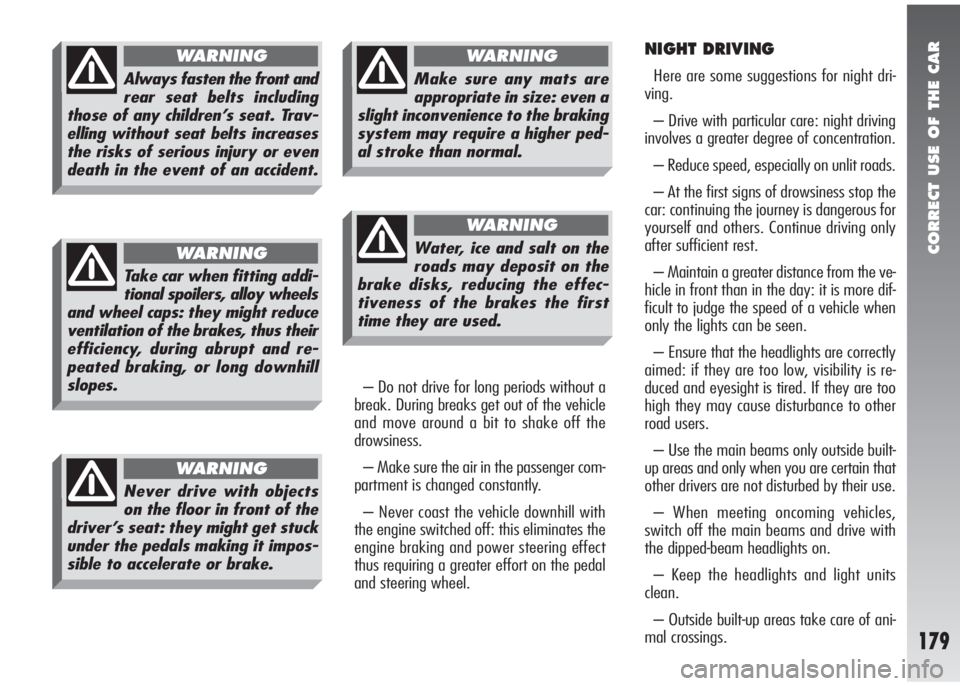
CORRECT USE OF THE CAR
179
– Do not drive for long periods without a
break. During breaks get out of the vehicle
and move around a bit to shake off the
drowsiness.
– Make sure the air in the passenger com-
partment is changed constantly.
– Never coast the vehicle downhill with
the engine switched off: this eliminates the
engine braking and power steering effect
thus requiring a greater effort on the pedal
and steering wheel.
NIGHT DRIVING
Here are some suggestions for night dri-
ving.
– Drive with particular care: night driving
involves a greater degree of concentration.
– Reduce speed, especially on unlit roads.
– At the first signs of drowsiness stop the
car: continuing the journey is dangerous for
yourself and others. Continue driving only
after sufficient rest.
– Maintain a greater distance from the ve-
hicle in front than in the day: it is more dif-
ficult to judge the speed of a vehicle when
only the lights can be seen.
– Ensure that the headlights are correctly
aimed: if they are too low, visibility is re-
duced and eyesight is tired. If they are too
high they may cause disturbance to other
road users.
– Use the main beams only outside built-
up areas and only when you are certain that
other drivers are not disturbed by their use.
– When meeting oncoming vehicles,
switch off the main beams and drive with
the dipped-beam headlights on.
– Keep the headlights and light units
clean.
– Outside built-up areas take care of ani-
mal crossings.Always fasten the front and
rear seat belts including
those of any children’s seat. Trav-
elling without seat belts increases
the risks of serious injury or even
death in the event of an accident.
WARNING
Take car when fitting addi-
tional spoilers, alloy wheels
and wheel caps: they might reduce
ventilation of the brakes, thus their
efficiency, during abrupt and re-
peated braking, or long downhill
slopes.
WARNING
Never drive with objects
on the floor in front of the
driver’s seat: they might get stuck
under the pedals making it impos-
sible to accelerate or brake.
WARNING
Make sure any mats are
appropriate in size: even a
slight inconvenience to the braking
system may require a higher ped-
al stroke than normal.
WARNING
Water, ice and salt on the
roads may deposit on the
brake disks, reducing the effec-
tiveness of the brakes the first
time they are used.
WARNING
Page 189 of 291
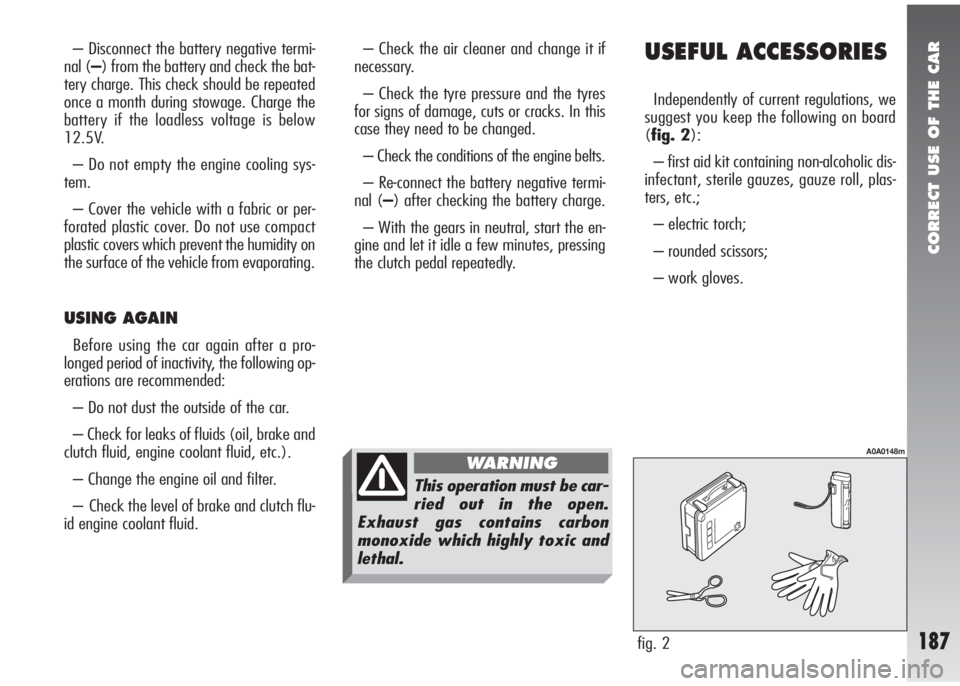
CORRECT USE OF THE CAR
187
USEFUL ACCESSORIES
Independently of current regulations, we
suggest you keep the following on board
(fig. 2):
– first aid kit containing non-alcoholic dis-
infectant, sterile gauzes, gauze roll, plas-
ters, etc.;
– electric torch;
– rounded scissors;
– work gloves.
fig. 2
A0A0148m
– Disconnect the battery negative termi-
nal (–) from the battery and check the bat-
tery charge. This check should be repeated
once a month during stowage. Charge the
battery if the loadless voltage is below
12.5V.
– Do not empty the engine cooling sys-
tem.
– Cover the vehicle with a fabric or per-
forated plastic cover. Do not use compact
plastic covers which prevent the humidity on
the surface of the vehicle from evaporating.
USING AGAIN
Before using the car again after a pro-
longed period of inactivity, the following op-
erations are recommended:
– Do not dust the outside of the car.
– Check for leaks of fluids (oil, brake and
clutch fluid, engine coolant fluid, etc.).
– Change the engine oil and filter.
– Check the level of brake and clutch flu-
id engine coolant fluid.– Check the air cleaner and change it if
necessary.
– Check the tyre pressure and the tyres
for signs of damage, cuts or cracks. In this
case they need to be changed.
– Check the conditions of the engine belts.
– Re-connect the battery negative termi-
nal (–) after checking the battery charge.
– With the gears in neutral, start the en-
gine and let it idle a few minutes, pressing
the clutch pedal repeatedly.
This operation must be car-
ried out in the open.
Exhaust gas contains carbon
monoxide which highly toxic and
lethal.
WARNING
Page 217 of 291

IN AN EMERGENCY
215
40
40
40
15
15
25
7.5
15
15
20
15
15
7.5
30
50 A/C (MAXI-FUSE)
FAN1 (MAXI-FUSE)
FAN2 (MAXI-FUSE)
F3
F4
F60 (*)
F11
F61 (*)
F62 (*)
F63 (*)
F46
F10
F12
EFI (MAXI-FUSE)
JB3 (MAXI-FUSE) 54
54
54
53
53
52
53
52
52
52
52
53
53
54
54
SERVICES FIGURE FUSE AMPERES
(*) Fuse behind dashboard control box on an auxiliary bracket.
Climate control fan
Radiator fan
Radiator fan
Horn
Fuel pump
Tailgate electric unlocking
Electronic injection system
Bose system
Bose system
Sunroof
Sun roof
Petrol/ignition coil injectors
Services
Electronic injection
Engine compartment fuse carrier module